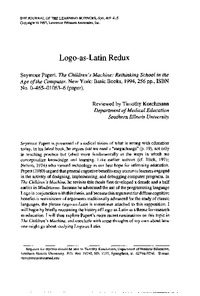Logo-as-Latin ReduxZu finden in: The Journal of the Learning Sciences 6(4) (Seite 409 bis 416), 1997
|
 |
 Diese Seite wurde seit 5 Jahren inhaltlich nicht mehr aktualisiert.
Unter Umständen ist sie nicht mehr aktuell.
Diese Seite wurde seit 5 Jahren inhaltlich nicht mehr aktualisiert.
Unter Umständen ist sie nicht mehr aktuell.
 Zusammenfassungen
Zusammenfassungen
 Seymour Papert is possessed of a radical vision of what is wrong with education
today. In his latest book, he argues that we need a "megachange" (p. 19), not only
in teaching practice but (also) more fundamentally in the ways in which we
conceptualize knowledge and learning. Like earlier authors (cf. Illich, 1971;
Nelson, 1974) who viewed technology as our best hope for reforming education,
Papert (1 980) argued that general cognitive benefits may accrue to learners engaged
in the activity of designing, implementing, and debugging computer programs. In
The Children's Machine, he revisits this thesis first developed a decade and a half
earlier in Mindstoims. Because he advocated the use of the programming language
Logo in conjunction with this thesis, and because this argument for diffuse cognitive
benefits is reminiscent of arguments traditionally advanced for the study of classic
languages, the phrase Logo-as-Latin is sometimes attached to this supposition. I
will begin by briefly recounting the history of Logo-as-Latin as a theme for research
in education. I will then explore Papert's more recent ruminations on this topic in
The Children's Machine, and conclude with some thoughts of my own about how
one might go about studying Logo-as--Latin.
Seymour Papert is possessed of a radical vision of what is wrong with education
today. In his latest book, he argues that we need a "megachange" (p. 19), not only
in teaching practice but (also) more fundamentally in the ways in which we
conceptualize knowledge and learning. Like earlier authors (cf. Illich, 1971;
Nelson, 1974) who viewed technology as our best hope for reforming education,
Papert (1 980) argued that general cognitive benefits may accrue to learners engaged
in the activity of designing, implementing, and debugging computer programs. In
The Children's Machine, he revisits this thesis first developed a decade and a half
earlier in Mindstoims. Because he advocated the use of the programming language
Logo in conjunction with this thesis, and because this argument for diffuse cognitive
benefits is reminiscent of arguments traditionally advanced for the study of classic
languages, the phrase Logo-as-Latin is sometimes attached to this supposition. I
will begin by briefly recounting the history of Logo-as-Latin as a theme for research
in education. I will then explore Papert's more recent ruminations on this topic in
The Children's Machine, and conclude with some thoughts of my own about how
one might go about studying Logo-as--Latin. Dieser wissenschaftliche Zeitschriftenartikel erwähnt ...
Dieser wissenschaftliche Zeitschriftenartikel erwähnt ...
 Dieser wissenschaftliche Zeitschriftenartikel erwähnt vermutlich nicht ...
Dieser wissenschaftliche Zeitschriftenartikel erwähnt vermutlich nicht ... 
 Nicht erwähnte Begriffe | Präoperationales Stadium |
 Tagcloud
Tagcloud
 Zitationsgraph
Zitationsgraph
 Zitationsgraph (Beta-Test mit vis.js)
Zitationsgraph (Beta-Test mit vis.js)
 Zeitleiste
Zeitleiste
 5 Erwähnungen
5 Erwähnungen 
- CSCL - Theory and Practice of an Emerging Paradigm (Timothy D. Koschmann) (1996)
- Paradigm shifts and instructional technology - An introduction


- Paradigm shifts and instructional technology - An introduction
- The Journal of the Learning Sciences 6(4) (1997)
- Remaining Trouble Spots with Computational Thinking - Addressing unresolved questions concerning computational thinking. (Peter Denning) (2017)


- The Charisma Machine - The Life, Death, and Legacy of One Laptop per Child (Morgan Ames) (2019)

- Designing Constructionist Futures - The Art, Theory, and Practice of Learning Designs (2020)

 Volltext dieses Dokuments
Volltext dieses Dokuments
 Anderswo suchen
Anderswo suchen 
 Beat und dieser wissenschaftliche Zeitschriftenartikel
Beat und dieser wissenschaftliche Zeitschriftenartikel
Beat hat Dieser wissenschaftliche Zeitschriftenartikel während seiner Zeit am Institut für Medien und Schule (IMS) ins Biblionetz aufgenommen. Beat besitzt kein physisches, aber ein digitales Exemplar. (das er aber aus Urheberrechtsgründen nicht einfach weitergeben darf). Es gibt bisher nur wenige Objekte im Biblionetz, die dieses Werk zitieren.









 Lernen
Lernen LOGO (Programmiersprache)
LOGO (Programmiersprache) Programmieren
Programmieren Sprache
Sprache











 , 396 kByte)
, 396 kByte)  Biblionetz-History
Biblionetz-History